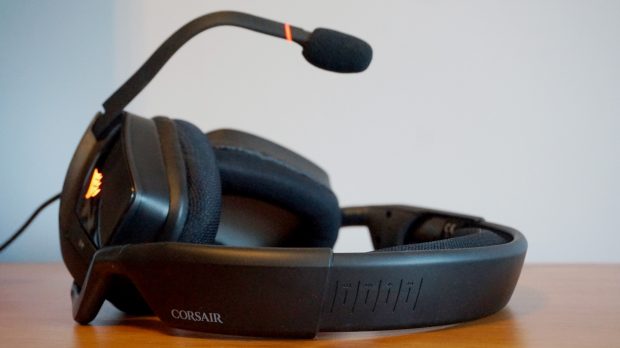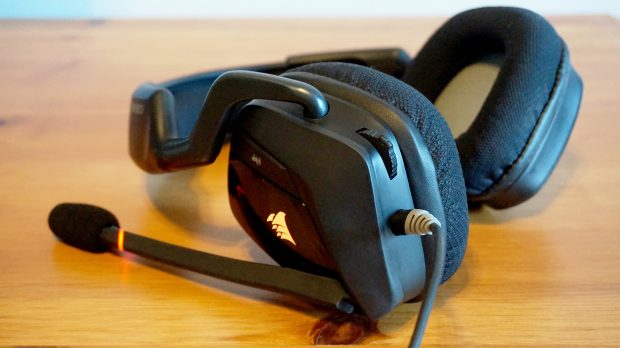
I assumed it will be ages earlier than I discovered one other pair of headphones that might rival Steelseries’ superb Arctis 7, however it seems nice headsets are a bit like buses. You wait ages after which two come alongside directly. This time, it’s Corsair’s Void Pro RGB.
Now I wouldn’t go so far as saying the Void Pro tops the Arctis 7, however it does come a mighty shut second. Available in wireless, USB and non-RGB ‘Surround‘ fashions, the Void Pro is supremely snug. This stunned me, because the Void Pro seems to be and looks like a number of lesser headsets I’ve tried earlier than – a good quantity of padding on prime, however essentially a fairly conventional headband design.
However, no matter type of reminiscence foam/microfibre combo Corsair’s used right here completely works, as I used to be capable of put on the Void Pro for hours on finish with out the slightest little bit of discomfort. I think it’s most likely as a result of its total design is considerably looser than your common headset, as I used to be capable of transfer it fairly simply round my head even when it was on the tightest adjustment setting.
The upside is that its looser match prevents the entire thing from consistently feeling prefer it’s pinching your cranium. On the opposite hand, it’s most likely not the only option in case your head occurs to be significantly small, significantly when the ear cups are additionally fairly giant. Still, it’s not like I felt it was about to slip off my face on the drop of a hat, and except you want moshing to thrash metallic whereas enjoying video games, I don’t actually foresee it being an issue. The plush ear cups felt greater than safe towards the aspect of my face, and I needed to exert fairly a little bit of power to knock them off my ears.

Admittedly, the copious quantity of plastic on the USB model of the Void Pro on check right here doesn’t actually mirror its considerably premium worth of £80/$80 (or £95 in case you’d fairly pay full whack over on Corsair’s own website). I don’t actually have a problem with it on the primary headband, however once you begin transferring the flexible, fold-down mic into place, it simply seems to be you’ve by accident sat on it. The mic’s additionally comprised of that type of thick, barely tough type of plastic that all the time manages to look a bit scruffy after you’ve used it for some time.
To its credit score, the microphone is great. Speech was crystal clear once I recorded myself speaking in Audacity, with solely the occasional little bit of pop/audible wind results creeping in on a few arduous plosives. This was shortly rectified by making use of the bundled foam windscreen, although, which eradicated all pop results in a single fell swoop.
The Void Pro’s fairly mild on onboard controls. All you get is a microphone mute button on the left ear cup (which prompts a skinny LED band close to the bottom so you possibly can inform it’s inactive in case you don’t have audio suggestions turned on) and a small quantity rocker that controls your PC’s grasp quantity, however you will discover extra settings in Corsair’s Utility Engine software program (or Cue, for brief).
I’m not the largest fan of Cue. It’s nowhere close to as easy or intuitive to make use of as different management centres I’ve put up with prior to now, however it will get the job completed. In it, you’ll discover equaliser settings for its 5 preset modes in addition to the choice to create your individual, microphone quantity and sidetone sliders (how a lot you possibly can hear your self by means of the headset once you speak) and RGB settings for the light-up Corsair logos on every ear cup.
You’ll additionally want Cue to activate its Dolby 7.1 encompass sound function, as annoyingly there isn’t a devoted button for it on the headset. Much like different 7.1 headsets, that is all completed through software program – you’d want seven particular person audio system and a subwoofer for true 7.1 encompass sound – however in fact I didn’t really feel there was an enormous distinction between having it on or off.
In Doom, the soundscape felt a little bit wider and atmospheric with 7.1 enabled, with imp fireballs possessing a fraction extra bass and depth to them as they had been hurled overhead, however the impact wasn’t significantly pronounced. It was even much less noticeable in Wolfenstein II and The Evil Within, with every of its busy soundtracks sounding kind of similar when switching between every mode.
Indeed, turning on the 7.1 Surround virtually destroyed Hellblade’s binaural audio, throwing Senua’s plague of voices out in entrance of me as an alternative of getting them jostling for consideration behind my ear. The whipping winds and rush and swirl of the world sounded nice, however the wrestle inside Senua’s thoughts fully misplaced its affect.
That’s to not say the Void Pro’s audio isn’t good. Games nonetheless sounded glorious in common stereo, and Doom’s gory finishers specifically sounded deliciously detailed as I continued to crack open recent batches of demon skulls. Likewise, Hellblade as soon as once more despatched shivers up my backbone as its voices hissed and whispered in my ear, and the speedy clicks of Wolfenstein II’s weapons sounded pleasingly weighty. It’s only a disgrace the 7.1 Surround doesn’t improve all of it additional.
General music listening, alternatively, was a bit hit or miss. When I fired up my trusty Final Fantasy XV soundtrack, for example, I felt its lighter piano tracks sounded fairly muted more often than not, whereas its busier, extra intense battle themes lacked the identical type of bass and affect I heard on Steelseries’ Arctis 7. Turning on 7.1 didn’t assist a lot both. Other varieties of music, in the meantime, reminiscent of indie rock tracks or the pumping opening to the primary season of Knights of Sidonia for instance, had been a lot clearer. The low finish was nonetheless most likely a smidge on the conservative aspect, however not so dangerous it wrecked your entire monitor.
It’s a disgrace, actually, because the Void Pro’s consolation and in-game stereo efficiency are arguably simply pretty much as good because the Arctis 7 and the USB mannequin on check right here is inexpensive, too. For me, although, the Arctis 7 continues to be price the extra £40 expense (or simply $20 if you’re in the US), because it not solely baggage you a extra versatile headset that sounds nice in any scenario, however it’s wi-fi as effectively. If your price range doesn’t fairly stretch that far, although, the Void Pro continues to be a terrific, if barely flawed different.




